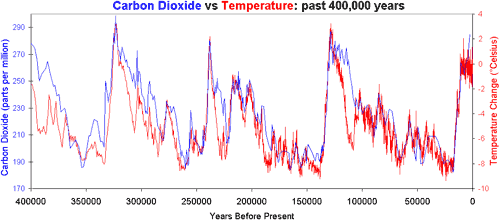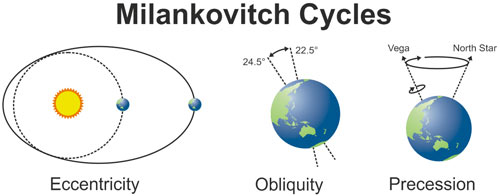
Figure 1: Vostok ice core records for carbon dioxide concentration (Petit 2000) and temperature change (Barnola 2003).
Over the last half million years, our climate has experienced long ice ages regularly punctuated by brief warm periods called interglacials. Atmospheric carbon dioxide closely matches the cycle, increasing by around 80 to 100 parts per million as Antarctic temperatures warm up to 10°C. However, when you look closer, CO2 actually lags temperature by around 1000 years. While this result was predicted two decades ago (Lorius 1990), it still surprises and confuses many. Does warming cause CO2 rise or the other way around? In actuality, the answer is both.

Figure 1: Vostok ice core records for carbon dioxide concentration (Petit 2000) and temperature change (Barnola 2003).
Interglacials come along approximately every 100,000 years. This is called the Milankovitch cycle, brought on by changes in the Earth's orbit. There are three main changes to the earth's orbit. The shape of the Earth's orbit around the sun (eccentricity) varies between an ellipse to a more circular shape. The earth's axis is tilted relative to the sun at around 23°. This tilt oscillates between 22.5° and 24.5° (obliquity). As the earth spins around it's axis, the axis wobbles from pointing towards the North Star to pointing at the star Vega (precession).

Figure 2: The three main orbital variations. Eccentricity: changes in the shape of the Earth’s orbit.Obliquity: changes in the tilt of the Earth’s rotational axis. Precession: wobbles in the Earth’s rotational axis.
The combined effect of these orbital cycles cause long term changes in the amount of sunlight hitting the earth at different seasons, particularly at high latitudes. For example, around 18,000 years ago, there was an increase in the amount of sunlight hitting the Southern Hemisphere during the southern spring. This lead to retreating Antarctic sea ice and melting glaciers in the Southern Hemisphere.(Shemesh 2002). The ice loss had a positive feedback effect with less ice reflecting sunlight back into space (decreased albedo). This enhanced the warming.
As the Southern Ocean warms, the solubility of CO2 in water falls (Martin 2005). This causes the oceans to give up more CO2, emitting it into the atmosphere. The exact mechanism of how the deep ocean gives up its CO2 is not fully understood but believed to be related to vertical ocean mixing (Toggweiler 1999). The process takes around 800 to 1000 years, so CO2 levels are observed to rise around 1000 years after the initial warming (Monnin 2001, Mudelsee 2001).
The outgassing of CO2 from the ocean has several effects. The increased CO2 in the atmosphere amplifies the original warming. The relatively weak forcing from Milankovitch cycles is insufficient to cause the dramatic temperature change taking our climate out of an ice age (this period is called a deglaciation). However, the amplifying effect of CO2 is consistent with the observed warming.
CO2 from the Southern Ocean also mixes through the atmosphere, spreading the warming north (Cuffey 2001). Tropical marine sediments record warming in the tropics around 1000 years after Antarctic warming, around the same time as the CO2 rise (Stott 2007). Ice cores in Greenland find that warming in the Northern Hemisphere lags the Antarctic CO2 rise (Caillon 2003).
To claim that the CO2 lag disproves the warming effect of CO2 displays a lack of understanding of the processes that drive Milankovitch cycles. A review of the peer reviewed research into past periods of deglaciation tells us several things:
Many thanks to Ari Jokimäki who has been tirelessly tracking down papers on Milankovitch cycles.
Posted by John Cook on Saturday, 9 January, 2010
 |
The Skeptical Science website by Skeptical Science is licensed under a Creative Commons Attribution 3.0 Unported License. |